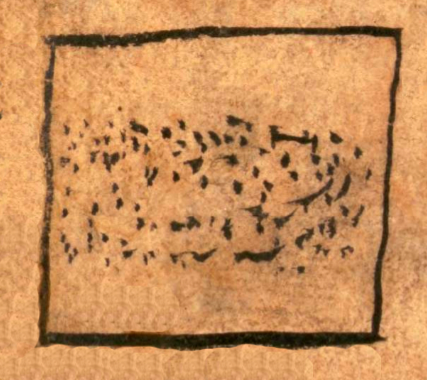Xalticpac (CQ)
This compound glyph for the place name Xalticpac ("On Top of the Sand") has two main features. One is a group of black dots signifying grains of sand (xalli). This sand is in a rectangle, which helps it appear to be on the ground, creating a bird's eye view. Perhaps this is the tlacuilo's method for conveying the locative -ticpac (above, over, on top of).
Stephanie Wood
The rectangle may also refer to a particular parcel of land, such as a tlalli or a milli. Many such rectangles in the Codex Quetzalecatzin, in fact, have glosses suggesting that they were called milli, and some of them were owned by particular elite members of the community. Representations of sand in the Codex Mendoza can be round, although sometimes the sand fills a particular shape of water or a gully. The dotted texturing is something both codices have in common, although, again, the Codex Mendoza will sometimes mix in some larger pieces of sand or stone. (See below.) Ofelia Cruz Morales suggests "adentro del la arena" ("inside the sand") as a translation, and this could be supported by the placement of the sand in this glyph in the middle of the parcel. In other words, the placement of the sand, which does not fill the rectangle, may have a semantic significance.
Stephanie Wood
Xalticpac
Xalticpac
Stephanie Wood
covers ruling men and women of Tecamachalco through 1593
Stephanie Wood
The shape and placement of the sand inside the rectangle (instead of filling it completely) made be significant. It is a method that diverges from other representations of sand in this database.
place, lugar, name, nombre, land, la tierra, sand, la arenilla, la arena, nombres de lugares

xal(li), sand, https://nahuatl.wired-humanities.org/content/xalli
-ticpac (locative suffix), above, over, on top of, https://nahuatl.wired-humanities.org/content/ticpac
Xalticpac “On Top of the Sand.” Matthew T. McDavitt, “Placenames in the Codex Quetzalecatzin,” unpublished essay shared 2-21-2018.
Sobre de la Arena, o Adentro de la Arena
Ofelia Cruz Morales
The Codex Quetzalecatzin, aka Mapa de Ecatepec-Huitziltepec, Codex Ehecatepec-Huitziltepec, or Charles Ratton Codex. Library of Congress. https://www.loc.gov/item/2017590521/
The Library of Congress, current custodian of this pictorial Mexican manuscript, hosts a digital version online. It is not copyright protected.





